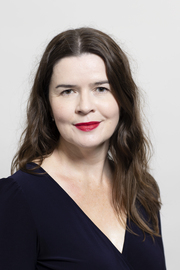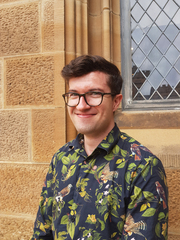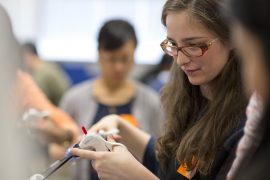Peer review for teaching is an observation and evaluation of teaching practices by colleagues. A common barrier to teachers engaging in peer review is the fear of being judged on something (teaching) that can be inherently vulnerable. Dr Kylie Giblett from the School of Languages and Cultures was initially sceptical about engaging in a process of peer review with academics from outside of her own discipline.
I was a little sceptical about this at first, but being reviewed by someone who teaches outside my own discipline was actually a fantastic way of getting some really novel teaching ideas. It was also a wonderful way of getting to meet colleagues from across the university.”
At Sydney, the Peer Review for Teaching (PRT) program is a University-wide initiative facilitated by the DVC (Education) Portfolio that provides a supportive process for educators wanting to engage in constructive feedback conversations using an evidence-based, university-endorsed proforma and expert accredited reviewers.

For firsthand insights into the PRT experience, we asked three educators from diverse disciplines to talk about their experiences with us:
- Dr Kylie Giblett from Arts and Social Sciences (Languages and Cultures)
- Mr Paul Briozzo from Engineering (Mechanical Engineering)
- Dr Tim Lee from Science (Life and Environmental Sciences)
What was the most surprising thing about peer review?
Kylie: The most surprising thing for me was being matched up with reviewers who were not from my faculty and worked in completely different academic disciplines to me. I was a little sceptical about this at first, but being reviewed by someone who teaches outside my own discipline was actually a fantastic way of getting some really novel teaching ideas. It was also a wonderful way of getting to meet colleagues from across the university.

Paul: The most surprising thing about the process was that there were two reviewers assigned to me. It was a valuable method, as it enabled me to compare the feedback from two independent reviews and note the similarities (there were many) and also areas in which they differed.
Tim: What really surprised me was how easy it was to set up from the perspective of the teacher – there is a template plan for the steps to go through, and there is not much organisation required from our end.
What do you now do differently (since your peer review/s)?
Kylie: The peer review process introduced me to some ideas that are commonly used in other disciplines that I could usefully apply in my own. For example, disciplines in Science and Engineering commonly use the platform Ed Discussions as a means of providing course information to students. I am now considering using this for my first-year beginner language units to provide clarification to students (and also to reduce the number of emails I have to answer!).

Paul: The main take-home message for me is that I quite often view my Canvas page, lectures, tutorials etc. from my perspective – not from the user’s perspective. Students sometimes do make comments (USS being one medium) but the peer lens (Brookfield, 2017) is incredibly valuable as it comes from a non-judgmental and supportive perspective that is also involved in the teaching process.
Tim: I have implemented a new section in each face-to-face class where we talk about upcoming assessments, focusing each time on one particular part that might be particularly challenging.
What would you say to a colleague who was unsure about being peer-reviewed?
Kylie: Go for it! There’s nothing to be afraid of. Remember: your peer reviewers are not there to give you a teaching exam. They are there to provide you with constructive feedback in a collegial setting and to give you useful tips that can help you make your teaching even better than it already is.
Paul: I highly recommend the process to any member of staff who is actively involved in teaching. Whether the USS score in the UOS they are involved is low, medium or high, the peer review process will only provide new insights, not judgment.
Tim: It’s a good experience – it’s very safe, it’s not designed to be punitive, and it’s a great way to get new perspectives on your teaching.
Final thoughts…
Having spoken to academics who have experienced the Peer Review of Teaching program, it was clear that once staff are able to overcome some of their initial (and perhaps understandable) apprehension about opening their teaching up to others, the benefits far outweigh the initial cost. Simple processes that place control of the final review with the reviewee alone really do create a safe space by which to gain fresh perspectives on teaching. The benefits are not only connecting with colleagues outside of your discipline but also learning about a wider array of teaching techniques and finding time for reflection and conversation with others.
I’ve now experienced this program from the perspective of a reviewer and a reviewee, and it’s been a great experience from both sides. I particularly value the chance to talk about teaching with other teachers from entirely different faculties.
Dr Tim Lee, peer review for teaching participant 2023
Read more and sign up
Find out more about the Peer Review for Teaching program at Sydney, including how to sign up for your own review:
- ‘Peer Review for Teaching for Participants 2024’ flyer: https://bit.ly/2024-PRT-1
- Receive personalised expert review and support for your teaching
- Using peer review as evidence and improvement of your teaching





